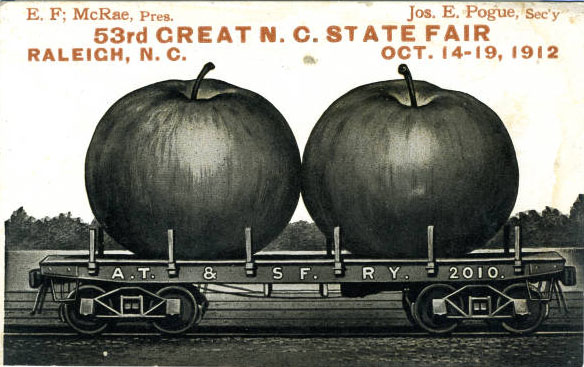Technology and the North Carolina State Fair
by Heather Overton
Reprinted with permission from the Tar Heel Junior Historian. Fall 2002.
Tar Heel Junior Historian Association, NC Museum of History
See also: NC State Fair: Agriculture (from Tar Heel Junior Historian); NC State Fair: History (from Tar Heel Junior Historian); State Fair
 The North Carolina State Agricultural Society, which produced the State Fair for seven decades before it began officially in 1853, focused primarily on agricultural reform, not attractions. Its official goal was to showcase progress and new ideas in agriculture and industry in North Carolina. Before television and easy transportation, the best way to see new technology in the state was to go to the fair.
The North Carolina State Agricultural Society, which produced the State Fair for seven decades before it began officially in 1853, focused primarily on agricultural reform, not attractions. Its official goal was to showcase progress and new ideas in agriculture and industry in North Carolina. Before television and easy transportation, the best way to see new technology in the state was to go to the fair.
Although some special attractions such as parades, musical acts, and sideshows appeared during the fair’s first decade, its focus remained on education. Special seminars were held to educate farmers on the latest technological advances in agriculture. The seminars included “The Bright Tobacco of North Carolina,” “The Farmer Should Be Educated,” and “The Grape: Its Care and Profits.” Residents came to the fair to learn about North Carolina and to take home new agricultural methods to try on the farm.
Fair organizers have maintained a long-standing tradition of showcasing technological advances at the fair. Often these advances are displayed beside the old ideas from which the modern improvements developed. Providing a place to showcase the latest in technology and other advances in the state is an important function of the State Fair.
At the State Fair in 1878, B. B. Stark of Western Union Telegraph connected a wire between the grandstand and an office to allow fairgoers to talk to one another on a new invention, the telephone. Electricity was first used at the fair in 1884. In 1894 a photography gallery was set up to take pictures for fairgoers. In 1910, several years after the Wright brothers’ first successful flight, the fair had an airplane exhibit. The tradition of showing the latest in technology continued throughout the twentieth century, with exhibits on national defense (1941), missiles (1957), space probes (1959), a subcritical atomic reactor (1958), nuclear energy (1961), a virtual reality ride called Cinesphere (1963), a model of the Apollo 12 command module (1972), and an exhibit on advances in computers called Cyberspace (1990s). The State Fair also continued to present the latest in agriculture, including exhibits on milking parlors, small grains, soybeans, cotton, landscaping, and forestry. Last year BioFrontiers, an exhibit on biotechnology in the state, premiered at the fair. Showcasing all aspects of biotechnology, it will return for the 2002 State Fair.
Changes in technology have also changed the way people have fun at the fair. In the late 1800s, fairgoers enjoyed the thrill of a merry-go-round powered by steam engines. However, the sideshows, bands, parades, political speakers, and spectator sports such as horse racing and baseball were more popular. Even as late as 1945, the carnival brought more sideshows than rides. The sideshows featured singing acts, daredevil stunts, magicians, and other acts designed to entertain fairgoers. Then in the 1950s, the fair began to introduce bigger thrill rides such as the double Ferris wheel. Over time, rides began to replace shows in popularity. Currently, the carnival brings about eighty rides to the fair. Today’s rides, powered by diesel-fuel generators, become more thrilling as technology improves. In 1997 the North Carolina State Fair introduced the Top Spin, a ride that launched fairgoers six stories in the air before plunging downward and flipping upside down. The midway, where most of the rides are located, is now one of the most popular places at the State Fair.
As technology advances, improvements are made to better accommodate fairgoers. Advance gate admission, ride books, and concert tickets can now be purchased on-line. Through advertising on television and radio, in newspapers, and over the Internet, people across the state know months in advance what will be at the fair so that they can plan their visits. Technology will continue to shape the fair in the future.
The State Fair is still the largest event in North Carolina. It attracts more than 700,000 people a year. Although most of the visitors now come to be entertained rather than educated, technology still plays a role in their fun.
At the time of this article’s publication, Heather Overton worked as a public information officer at the North Carolina Department of Agriculture and Consumer Services in Raleigh.
Image credit:
"Postcard from the 1912 North Carolina State Fair." Original image at UNC Libraries, North Carolina Collection. Online at LearnNC: http://www.learnnc.org/lp/multimedia/12875
1 January 2002 | Overton, Heather